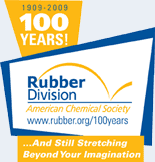![[ Visit ACS Rubber Website ]](images/logo.jpg) |
|
Centennial Elite SponsorsBecome a Centennial Elite Sponsor |
96 REINFORCEMENT EFFECT OF NOVEL MODIFIED FUMED SILICA IN STYRENE-BUTADIENE RUBBERSWednesday, October 14, 2009: 3:15 PM
330 (David L. Lawrence Convention Center )
Rubbers are polymeric materials characterized by their high elasticity. However, the reinforcement of these soft matrices is essential to obtain the required properties for their different practical applications. In order to achieve the final requirements, rubber compounds contains different additives, where fillers play an important role. In this sense, silica is being the main inorganic filler in rubber technology. However, silica surface has to be modified with coupling agents in order to overcome all processing problems and the poor reinforcement showed by the pristine silica. Studies on precipitated silica are frequently in rubber science, though the use of fumed silica is more restricted since it offers a fluffy power difficult to incorporate into the rubber matrix via habitual procedures. The aim of this work is the optimization of a modification method that allows incorporating fumed silica particles into the rubber matrix.
The modification method is based on the pre-treatment of the silica surface in solution, after being submitted to high ultrasonic energy. Silica surface was treated with different silanes coupling agents, obtaining a stable suspension of nano-sized aggregates. As a result of this modification, the original processing problems showed by the pristine fumed silica were overcome, even at high loading fractions of silica. In addition, the heating step needed during the rubber compounding to favour silica-silane reaction, is eliminated since silica surface has been already pre-treated. Styrene-butadiene rubber (SBR) compounds filled with pre-treated fumed silica show improved reinforcement mainly due to both factors: in one hand, the improvement of filler dispersion as deduced by electron microscopy, and on the other, strong filler-elastomer interactions as investigated by 1H low field NMR spectroscopy. |









